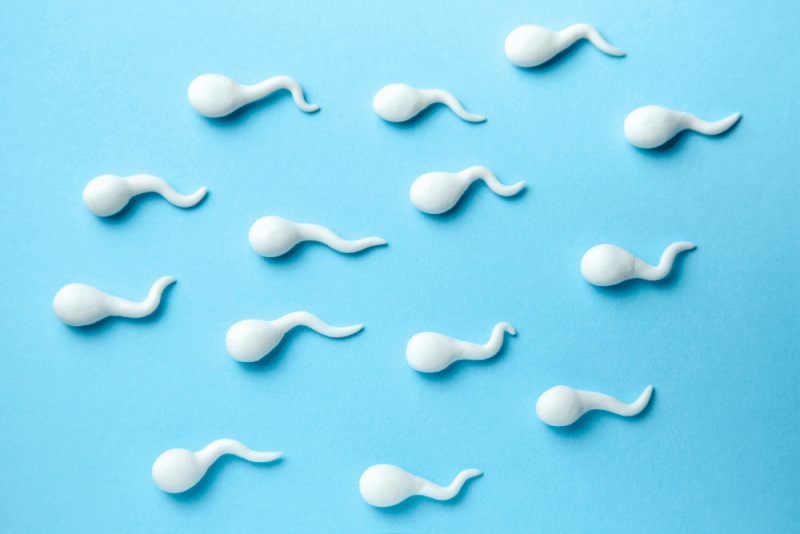Myths and exaggerated ideas are common when it comes to sexual matters. This also applies to the question of how long it takes for men to reach climax during sex. The duration depends on many factors and can vary over time.
When timed with a stopwatch, it takes a man an average of 5 to 7 minutes to reach climax and ejaculate. However, this duration can range widely: from less than a minute to more than half an hour.
Whether and how much premature ejaculation affects a man varies greatly depending on his relationship and sexual satisfaction. Studies show that men sometimes estimate the time it takes them to ejaculate as much as four times longer than it actually takes. Therefore, basing your understanding on what others say is not a good idea.
About 4% of men have almost no control over their ejaculation. It always or almost always occurs very early, for example, before or right after penetration. Premature ejaculation is suspected when early orgasm becomes a burden. In such cases, various treatments, including medication under certain conditions, are possible. Sex therapy may also be an option.
Types of Premature Ejaculation
There are four different types of premature ejaculation problems in men. These include lifelong premature ejaculation, acquired premature ejaculation, emotional premature ejaculation, and variable premature ejaculation.
Lifelong Premature Ejaculation
Lifelong premature ejaculation usually starts with the first sexual experience and continues throughout an individual's life. Although it is a rare type, its prevalence in society ranges between 2.3% and 3.2%.
Acquired Premature Ejaculation
Acquired premature ejaculation is a common type of premature ejaculation, influenced by both physiological and psychological factors and usually occurs due to changes. Sexual therapy has great success in treating acquired premature ejaculation. Its prevalence ranges from 3.9% to 4.8%.
Variable Premature Ejaculation
Variable premature ejaculation is the most commonly encountered type, affecting 8.5% to 11.4% of the population. It can be due to physiological or psychological reasons. The distinguishing feature of variable premature ejaculation is that men may not experience the problem in some sexual relations but do in others.
Emotional Premature Ejaculation
Also known as subjective premature ejaculation, emotional premature ejaculation is usually not related to actual premature ejaculation. Despite the ejaculation time being within normal limits during sexual intercourse, a man may feel that he has ejaculated prematurely. The cause of emotional premature ejaculation is psychological and cultural influences. The prevalence among those with premature ejaculation issues ranges from 5.1% to 6.4%.
What is the Duration of Premature Ejaculation?
Premature ejaculation is fundamentally uncontrolled ejaculation. Therefore, in addition to the duration of ejaculation, whether the person ejaculates involuntarily also plays a role in diagnosis:
- Under 1 minute
- Between 1 and 3 minutes
- Between 3 and 7 minutes
- Over 7 minutes but still involuntary
Another important factor for the diagnosis of premature ejaculation is the level of sexual satisfaction of the individual and their partner.
What are the Consequences of Premature Ejaculation?
Untreated premature ejaculation can negatively affect a man's sex life and his psychology. Therefore, the side effects of premature ejaculation include:
- Decrease in self-confidence
- Feeling of shame
- Increase in anxiety
- Lack of sexual desire
- Internal anger
- Conflict in sexual relationships
- Deterioration of relationship quality
Causes of Premature Ejaculation
The causes of premature ejaculation are not well-researched. Until now, there have only been assumptions: Some experts assume biological factors such as an overly sensitive penis or changes in the penis's interaction with hormones and nerves.
Others see psychological factors such as relationship issues or fear of failure as the cause. Both biological and psychological factors can be jointly responsible and can influence each other.
Some men have struggled with premature ejaculation from the beginning of their sexual lives. For others, it appears later in life. This is referred to as "acquired" premature ejaculation.
In general, premature ejaculation can occur at any age. Occasional premature ejaculation is not necessarily a cause for concern. It can occur particularly in young men, often due to unfamiliar sexual situations. However, prolonged premature ejaculation usually creates a significant psychological burden for those affected and can negatively impact a relationship and lead to interpersonal difficulties. "Fear of failure" can lead to avoidance behavior and a reduction in sexual activities (number of sexual contacts).
Symptoms of Premature Ejaculation
The duration of a man's ejaculation during sexual intercourse varies greatly. On average, it takes about five minutes, but it can significantly vary, being longer or shorter.
Many men have involuntarily ejaculated too quickly. This occasional occurrence is not a concern and depends on mood, situation, and internal tension. However, if ejaculation regularly occurs too early, it is a pathological sexual dysfunction. Doctors then refer to it as premature ejaculation or ejaculatio praecox. Affected men then experience ejaculation almost always or always before they can control it during sexual activity. Satisfactory sexual intercourse is then hardly possible.
Premature ejaculation can be psychologically very stressful for both the man and his sexual partner. There is no objective way to determine when ejaculation is "too early" or "normal." Instead, the diagnosis depends on the personal impression of the man or couple and their level of distress.
Addressing premature ejaculation often requires significant effort. To diagnose PE, a doctor conducts a detailed anamnesis interview that must include not only physical information but also honest details about social and sexual life.
A thorough medical history (e.g., psychotropic medications) is essential. The doctor will clarify whether it is a primary or secondary (lifelong or acquired) PE. Various examinations are conducted, including urological ones. Possible underlying diseases are included in the diagnosis (e.g., urethral inflammation). It is also important to determine whether the affected man is really suffering from PE or if it is suspected only because of incorrect assumptions about the "right" time for ejaculation.
Methods of Treating Premature Ejaculation
Deciding how you want to treat premature ejaculation is a very personal question. There are various options available for treatment:
- Some techniques are designed to help you better control ejaculation by intentionally delaying it. For example, one option is to stimulate the penis to the brink of climax repeatedly and then stop.
- Medications can slightly increase the time needed to ejaculate. There are oral medications and numbing agents applied to the tip of the penis (glans). Both can have side effects.
- Sex therapy treatments aim to boost confidence in men or couples and eliminate the fear of sexual "inadequacy." Another goal is to focus less on ejaculation and experience sexuality in a more varied way. In some specific cases, relationship issues can also be discussed.
Selective serotonin reuptake inhibitors (SSRIs) are commonly used in medication therapy. To date, the only drug approved in Europe from this group (dapoxetine), extends the time to ejaculation by an average of only 1 to 1.5 minutes. Other SSRIs are significantly cheaper and also more effective. They can be prescribed by a doctor as an "off-label" treatment.
Medical Therapy
Medication therapy can be in the form of tablets, gels, or creams:
Oral Medication Therapy
The active ingredient dapoxetine is used to delay ejaculation in premature ejaculation by affecting the ejaculation reflex in the brain (oral therapy in tablet form). For example, if you have erectile dysfunction, other medications may also be prescribed. Your doctor will inform you about the use of other medications.
Topical Medication Therapy
Anesthetic gels and creams are applied to the glans of the penis in men to reduce sensation and therefore stimulation.
Non-Medical Mechanical Therapy (Behavioral Measures)
Non-medical techniques like the start-stop technique and the squeeze technique try to delay ejaculation.
Start-Stop Technique
With this technique, the penis is stimulated and the stimulation is stopped just before ejaculation (or just before the sensation that ejaculation is inevitable). Stimulation is resumed after the arousal has decreased.
Squeeze Technique
With this technique, the penis is squeezed just before the peak - the penis head and index finger (in the area of the frenulum) are squeezed from above and below to interrupt. By squeezing, the urge to ejaculate is suppressed and ejaculation is delayed.
Prevalence
The sensation of ejaculating too early is very subjective. It is also sometimes intentionally reinforced by public campaigns about premature ejaculation. They are often financed by pharmaceutical companies and emerge with the intention of "breaking taboos."
However, exaggerating the frequency of the problem is a typical feature of such campaigns. It is often claimed that between 20% to 30% of all men are affected by premature ejaculation. This is based solely on the duration until ejaculation. If scientifically recognized diagnostic criteria are applied, the estimates are at most 4%. It also takes into account how often premature ejaculation occurs and whether it is a burden for a man.
Premature Ejaculation Exercises
Premature ejaculation exercises aim to strengthen the pelvic floor muscles. To identify these muscles, you first need to try stopping your urine flow while using the bathroom. The muscles that contract to hold the urine are the pelvic floor muscles, and the Kegel exercise for strengthening these muscles is used in the treatment of premature ejaculation. When you tighten the pelvic floor muscles while facing a mirror, you can observe the penis moving closer to the abdomen and the testicles lifting upwards.
First Stage
In the first stage, you learn how to control the pelvic floor muscles. For this, you need to tighten the muscles around the anus as if you are holding in gas. However, it is important not to tighten the buttock muscles while doing this. This stage needs to be repeated several times to learn which muscles need to be tightened.
Second Stage
In this stage, where the technique is perfected, the Kegel exercise should be done after emptying the bladder. Then, lie on your back with your knees bent at a 90-degree angle. Next, tighten the pelvic floor muscles and hold for 3 seconds, then relax them for 3 seconds. Continue to alternately tighten and relax the muscles, but it is important not to overdo the exercises.
Third Stage
In the progression stage, the third stage, there is no need to lie down on a flat surface to perform the exercise. In this stage, the Kegel exercise can be continued while sitting, standing, or moving.
Remember to focus while performing premature ejaculation exercises. It is important to breathe normally during the exercises. The exercises should be done 3 times a day, in 3 sets of 10 repetitions each.
Finally, after performing the slow contractions mentioned previously, you can perform 5-10 rapid contractions.







